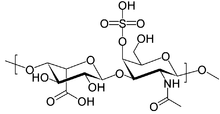Dermatan sulfate: Difference between revisions
YitzhakNat (talk | contribs) |
Adding information about Sulodexide with reference |
||
| Line 29: | Line 29: | ||
'''Dermatan sulfate''' is a [[glycosaminoglycan]] (formerly called a mucopolysaccharide) found mostly in [[skin]], but also in [[blood vessels]], [[heart valves]], [[tendons]], and [[lungs]]. |
'''Dermatan sulfate''' is a [[glycosaminoglycan]] (formerly called a mucopolysaccharide) found mostly in [[skin]], but also in [[blood vessels]], [[heart valves]], [[tendons]], and [[lungs]]. |
||
It is also referred to as [[chondroitin sulfate|chondroitin sulfate B]],<ref name = "Trowbridge_2002">{{cite journal | vauthors = Trowbridge JM, Gallo RL | title = Dermatan sulfate: new functions from an old glycosaminoglycan | journal = Glycobiology | volume = 12 | issue = 9 | pages = 117R–25R | date = September 2002 | pmid = 12213784 | doi = 10.1093/glycob/cwf066 | doi-access = free }}</ref> although it is no longer classified as a form of chondroitin sulfate by most sources. The formula is C<sub>14</sub>H<sub>21</sub>NO<sub>15</sub>S. This carbohydrate is composed of linear polymers of disaccharide units that contain, [[N-acetyl galactosamine]] (GalNAc) and [[iduronic acid]] (IdoA). These repeating units are sulfated at a variety of positions.<ref>{{Cite web|url=https://pubchem.ncbi.nlm.nih.gov/compound/Dermatan-sulfate|title = Dermatan sulfate}}</ref> |
It is also referred to as [[chondroitin sulfate|chondroitin sulfate B]],<ref name = "Trowbridge_2002">{{cite journal | vauthors = Trowbridge JM, Gallo RL | title = Dermatan sulfate: new functions from an old glycosaminoglycan | journal = Glycobiology | volume = 12 | issue = 9 | pages = 117R–25R | date = September 2002 | pmid = 12213784 | doi = 10.1093/glycob/cwf066 | doi-access = free }}</ref> although it is no longer classified as a form of chondroitin sulfate by most sources. The formula is C<sub>14</sub>H<sub>21</sub>NO<sub>15</sub>S. This carbohydrate is composed of linear polymers of disaccharide units that contain, [[N-acetyl galactosamine]] (GalNAc) and [[iduronic acid]] (IdoA). These repeating units are sulfated at a variety of positions.<ref>{{Cite web|url=https://pubchem.ncbi.nlm.nih.gov/compound/Dermatan-sulfate|title = Dermatan sulfate}}</ref> Dermatan sulfate is a competent of the compound [[sulodexide]].<ref name="Lasierra-Cirujeda 2010">{{cite journal | last=Lasierra-Cirujeda | first=J | last2=Coronel | first2=P | last3=Aza | first3=MJ | last4=Gimeno | first4=M | title=Use of sulodexide in patients with peripheral vascular disease | journal=Journal of Blood Medicine | volume=1 | date=2010 | pmid=22282689 | doi=10.2147/JBM.S10558 | url=https://www.ncbi.nlm.nih.gov/pmc/articles/PMC3262318/ | access-date=24 February 2022 | page=}}</ref> |
||
== Function == |
== Function == |
||
Revision as of 09:07, 24 February 2022
 | |
| Clinical data | |
|---|---|
| AHFS/Drugs.com | International Drug Names |
| ATC code | |
| Identifiers | |
| CAS Number | |
| ChemSpider |
|
| ChEMBL | |
| CompTox Dashboard (EPA) | |
| ECHA InfoCard | 100.042.305 |
| Chemical and physical data | |
| Formula | C14H21NO15S |
| Molar mass | 475.37 g·mol−1 |
| | |
Dermatan sulfate is a glycosaminoglycan (formerly called a mucopolysaccharide) found mostly in skin, but also in blood vessels, heart valves, tendons, and lungs.
It is also referred to as chondroitin sulfate B,[1] although it is no longer classified as a form of chondroitin sulfate by most sources. The formula is C14H21NO15S. This carbohydrate is composed of linear polymers of disaccharide units that contain, N-acetyl galactosamine (GalNAc) and iduronic acid (IdoA). These repeating units are sulfated at a variety of positions.[2] Dermatan sulfate is a competent of the compound sulodexide.[3]
Function
Dermatan sulfate may have roles in coagulation, cardiovascular disease, carcinogenesis, infection, wound repair, maintains the shape of galactosamine 4-sulfate skin and fibrosis.[1]
Pathology
Dermatan sulfate accumulates abnormally in several of the mucopolysaccharidosis disorders.
An excess of dermatan sulfate in the mitral valve is characteristic of myxomatous degeneration of the leaflets leading to redundancy of valve tissue and ultimately, mitral valve prolapse (into the left atrium) and insufficiency. This chronic prolapse occurs mainly in women over the age of 60, and can predispose the patient to mitral annular calcification. Mitral valve insufficiency can lead to eccentric (volume dependent or dilated) hypertrophy and eventually left heart failure if untreated.
See also
References
- ^ a b Trowbridge JM, Gallo RL (September 2002). "Dermatan sulfate: new functions from an old glycosaminoglycan". Glycobiology. 12 (9): 117R–25R. doi:10.1093/glycob/cwf066. PMID 12213784.
- ^ "Dermatan sulfate".
- ^ Lasierra-Cirujeda, J; Coronel, P; Aza, MJ; Gimeno, M (2010). "Use of sulodexide in patients with peripheral vascular disease". Journal of Blood Medicine. 1. doi:10.2147/JBM.S10558. PMID 22282689. Retrieved 24 February 2022.
{{cite journal}}: CS1 maint: unflagged free DOI (link)
External links
- Dermatan+sulfate at the U.S. National Library of Medicine Medical Subject Headings (MeSH)
